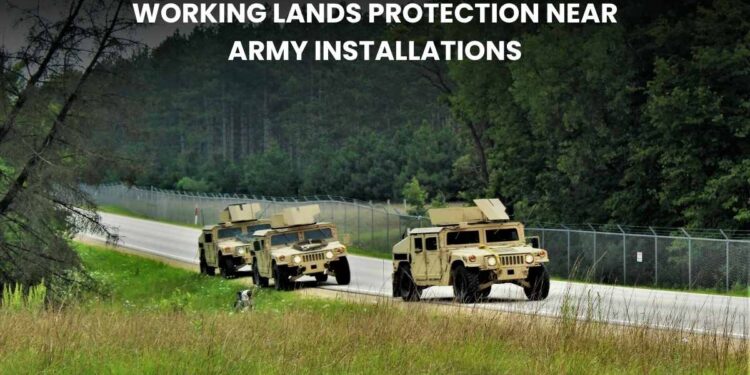The protection of working lands near army installations is encouraged by the defence authorities to safeguard military training areas from environmental restrictions and urban encroachment. Let’s see how the US DoD protects working land protection and supports the military and community needs.
The working lands near the army installation include publicly or privately owned lands, such as forests, farms, grasslands, agricultural land, and others that are used for grazing, agriculture, and conservation. These lands protect the army training areas and provide uninterrupted landscapes.
The US DoD protects such working lands through various initiatives and partnerships with the landowners. The army controls the largest share of the lands under DoD administration that are rich in natural resources and have various species, flora & fauna.
Why do Working Lands near Army Installations need protection?
To protect the working lands near the army installation, let’s see what the needs for protection and threats are that the government and other stakeholders need to mitigate:
- Encroachment:
- The military has nearly 30 million acres of land, and the Army has around 148 installations that have natural resources and need development.
- However, if the development is incompatible and can cause disruptions for the military training activities and other options, it can create problems.
- Military Readiness
- The military installations are set up for training, equipment testing, and exercises with foreign forces and others, so they need an uninterrupted area that meets the legal limit for the operations, and meet the safety concerns.
- Climate Resilience:
- The protection of working lands would help in reducing the impact of climate change and maintaining the ecosystem.
- The working lands are a natural buffer against the extreme weather events that can affect the army installations.
- National Security:
- The armed forces scale their combat capabilities through proper training, and for the smooth training operations, they need undisturbed lands or working lands near the army installation.
- Community Engagement:
- The working land generates revenue for the local communities and enables economic stability. The protection will allow the communities to use the lands productively.
- Habitat Loss:
- The development and encroachment can threaten the natural habitat; hence, to protect it, we need to protect the working land too.
What are the programs for the protection of the working lands near army installations?
The US federal agencies, such as DoD, US Fish & Wildlife Services, USDA, and many others, have started programs for working land near army installation protections, such as:
- Integrated Natural Resources Management Plans:
- The INRMPs aimed to manage the natural resources and meet the requirements, along with improving the military training conditions.
- Army Compatible Use Buffer Program:
- The ACUB program was designed to reduce the incompatible development around the military installations, conserve the lands, and assist the landowners.
- The program protects the endangered and threatened species, protects natural resources, promotes climate resilience, and habitat conservation.
- Army Natural Resources Partnership:
- Along with the US FWS, the Army finds ways to protect natural habitat and the land near the Army installation for sustainable military training and operations.
- REPI:
- The REPI program of DoD supports projects and partnerships that focus on reducing environmental restrictions on the military installations and improving military readiness.
- Conservation Encroachments:
- It’s an initiative under the REPI program, where the REPI and other partners engage with landowners for conservation encroachments on their property.
What are the initiatives promoting working land near the army installations’ protection?
The federal agencies promote the working land protection through the following awards and initiatives:
- Military Lands Conservation Initiatives:
- The initiatives include the Sentinel Landscape partnership and REPI for the conservation of lands near Army installations and ensuring smooth military training.
- Military Conservation Partner Award:
- The US FWS awards the army installations for exceptional work in conservation of land near the installation, and protecting the habitat, while also looking out for military readiness.
What are the outcomes of the working lands protection?
Now, let’s what the outcome of the initiatives and programs of various federal agencies for preserving the working land:
- The ACUB protects around 390903 acres of land and preserves the natural landscape, and also supports military training.
- The programs have increased the engagement between local communities and the military as both are working for the preservation of the working land.
- The initiatives have encouraged the army installations to preserve the working land and work together with communities for mutual benefits.
- The farmers, ranchers, or landowners near the army installation will continue to earn while not affecting the military operations.
The land near the army installation needs to be preserved not only for the natural habitat but also for the military also, as it is important for training and operations.











